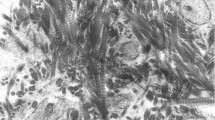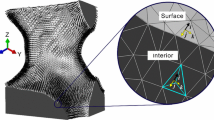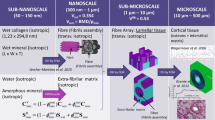Abstract
It has long been thought that collagen fibers within the bone matrix are deposited in an aligned pattern that channels mineral growth. If this model of bone structure is correct, both organic and inorganic phases of bone should have similar elastic anisotropy. Using an acoustic microscope, we measured longitudinal and transverse acoustic velocities of cortical specimens taken from 10 dog femurs before and after removal of either the mineral (using 10% EDTA) or collagen phases (using 7% sodium hypochlorite) and calculated longitudinal (CL) and transverse (CT) elastic coefficients. The anisotropy ratio (CL/CT) decreased significantly after demineralization (1.61 before versus 1.06 after, P<0.0001, paired t-test). However, there was no significant change after decollagenization (1.51 before versus 1.48 after, P=0.617, paired t-test). We conclude that the orientation of mineral crystals is the primary determinant of bone anisotropy, and the collagen matrix within osteonal bone has little directional orientation.
Similar content being viewed by others
References
Hodge AJ, Petruska JA (1963) Recent studies with the electron microscope on ordered aggregates of the tropocollagen molecule. In: Ramachandran GN (ed) Aspects of protein structure. Academic Press, New York, pp 289–300
Hodge AJ (1989) Molecular models illustrating the possible distributions of ‘holes’ in simple systematically staggered arrays of type I collagen molecules in native-type fibrils. Connect Tissue Res 21:137–147
Glimcher MJ (1976) Composition, structure and organization of bone and other mineralized tissues and mechanism of calcification. In: Creep RO, Astwood EB (eds) Handbook of physiology: endocrinology, vol 7. American Physiologic Society, Washington, DC, pp 25–116
Landis WJ, Paine MC, Glimcher MJ (1977) Electron microscopic observations of bone tissue prepared anhydrously in organic solvents. J Ultrastruct Res 59:1–30
Posner AS (1987) Bone mineral and the mineralization process In: Peck WA (ed) Bone and mineral research 5. Excerpta Medica, Amsterdam-Oxford-Princeton, pp 65–116
Lees S (1981) A mixed packing model for bone collagen. Calcif Tissue Int 33:591–602
Lees S (1987) Possible effect between the molecular packing of collagen and the composition of bony tissues. Int J Biol Macromol 9:321–326
Lees S, Prostak K (1988) The locus of mineral crystallites in bone. Connect Tissue Res 18:41–54
Arsenault AL (1989) A comparative electron microscopic study of apatite crystals in collagen fibrils of rat bone, dentin and calcified turkey tendons. Bone Miner 6:165–177
Höhling HJ, Barckhaus RH, Krefting ER, Althoff J, Quint P (1990) Collagen mineralization: aspects of the structural relationship between collagen and the apatitic crystallites. In: Bonnuci E, Motta PM (eds) Ultrastructure of skeletal tissues. Kluwer Academic Publishers, pp 41–62
Nylen MU, Scott DB, Mosley VM (1960) Mineralization of turkey tendon. II. Collagen-mineral relations revealed by electron and X-ray microscopy. In: Sognnaes RF (ed) Calcification in biological systems. American Association for the Advancement of Science, Washington, DC, pp 129–142
Myers HM, Engström A (1965) A note on the organization of hydroxyapatite in calcified tendons. Exp Cell Res 40:182–185
Engström A (1966) Apatite-collagen organization in calcified tendon. Exp Cell Res 43:241–245
Eanes ED, Lundy DR, Martin GN (1970) X-ray diffraction study of the mineralization of turkey leg tendon. Calcif Tissue Res 6:239–248
Lundy DR, Eanes ED (1973) An x-ray line-broadening study of turkey leg tendon. Arch Oral Biol 18:813–826
White SW, Hulmes DJS, Miller A, Timmins PA (1977) Collagen-mineral axial relationship in calcified turkey leg tendon by X-ray and neutron diffraction. Nature 266:421–425
Berthet-Colominas C, Miller A, White SW (1979) Structural study of the calcifying collagen in turkey leg tendons. J Mol Biol 134:431–445
Landis WJ (1986) A study of calcification in the leg tendons from the domestic turkey. J Ultrastruct Res 94:217–238
Landis WJ, Moradian-Oldak J, Weiner S (1991) Topographic imaging of mineral and collagen in the calcifying turkey tendon. Connect Tissue Res 25:181–196
Arsenault AL (1988) Crystal-collagen relationships in calcified turkey legtendon visualized by selected-area dark field electron microscopy. Calcif Tissue Int 43:202–212
Traub W, Arad T, Weiner S (1989) Three-dimensional ordered distribution of crystals in turkey tendon collagen fibers. Proc Natl Acad Sci USA 86:9822–9826
Traub W, Arad T, Weiner S (1992) Growth of mineral crystals in turkey tendon collagen fibers. Connect Tissue Res 28:99–111
Traub W, Arad T, Weiner S (1992) Origin of mineral crystal growth in collagen fibrils. Matrix 12:251–255
Lees S, Page EA (1992) A study of some properties of mineralized turkey leg tendon. Connect Tissue Res 28:263–287
Weiner S, Traub W (1992) Bone structure: from ångstroms to microns. FASEB J 6:879–885
Wagner HD, Weiner S (1992) On the relationship between the microstructure of bone and its mechanical stiffness. J Biomech 25:1311–1320
Fratzl P, Groschner M, Vogl G, Plenk H Jr, Eschberger J, Frantzl-Zelman N, Koller K, Klaushofer K (1992) Mineral crystals in calcified tissues: a comparative study by SAXS. J Bone Miner Res 7:329–334
Bonar LC, Lees S, Mook HA (1985) Neutron diffraction studies of collagen in fully mineralized bone. J Mol Biol 181:265–270
Matsushima N, Hikichi K (1989) Age changes in the crystallinity of bone mineral and in the disorder of its crystal. Biochim Biophys Acta 992:155–159
Gebhardt RSMW (1906) Uber funktionell wichtige Anordungweisen der feineren und gorberen Baulemente des Wirbeltierknochens. II. Spezieller Teil. I. Der Bau der Haversschen Lamellensystem und seine funktionelle Bedeuntung. Arch Entw Mech Org 20:187–334
Ascenzi A, Bonucci E (1970) The mechanical properties of the osteon in relation to its structural organization. In: Balazs EA (ed) Chemistry and molecular biology of the intercellular matrix. Academic Press, New York
Ranvier J (1889) Traite Technique d'Histologie, Savy, Paris
Ruth EB (1947) Bone studies. I. Fibrillar structure of adult human bone. Am J Anat 80:35–53
von Ebner V (1887) Sind die Fibrillen des Knochengewebes verkalkt oder nicht? Arch Mikrosk Anat 29:213–236
Weidenreich F (1923) Knochestundien. I. Teil: Uber Aufbau und Entwicklung des Knochens und Character des Knochengewebes. Zeitschrift fur Anat und Entwick 69:382–466
Marotti G, Muglia MA (1988) A scanning electron microscope study of human bony lamellae. Proposal for a new model of collagen lamellar organization. Arch Ital Anat Embriol 93:163–175
Marotti G (1993) A new theory of bone lamellation. Calcif Tissue Int 53(suppl):S47-S56
Zimmerman MC, Meunier A, Katz JL, Christel P (1990) The evaluation of cortical bone remodeling with a new ultrasonic technique. IEEE Trans Biomed Eng 37:433–441
Katz JL (1993) Scanning acoustic microscope studies of the elastic properties of osteons and osteon lamellae. J Biomech Eng 115:543–548
Hasegawa K, Wu E, Turner CH, Burr DB, Recker RR (1993) Acoustic velocity in osteoporotic compared to normal bone. J Bone Miner Res 8(suppl):S331
Yoon HS, Katz JL (1976) Ultrasonic wave propagation in human cortical bone: II. Measurements of elastic properties and microhardness. J Biomech 9:459–464
Van Buskirk WC, Ashman RB (1981) The elastic moduli of bone. In: Cowin SC (ed) Mechanical properties of bone. American Society of Mechanical Engineers, New York, pp 131–143
Ashman RB, Cowin SC, Van Buskirk WC, Rice JC (1984) A continuous wave technique for the measurement of the elastic properties of cortical bone. J Biomech 17:349–361
Lees S, Klopholz DZ (1992) Sonic velocity and attenuation in wet compact cow femur for the frequency range 5 to 100 MHz. Ultrasound Med Biol 18:303–308
Chandran A, Pidaparti RMV, Turner CH (1994) Anisotropy of osteonal bone. American Society for Mechanical Engineers Winter Annual Meeting, Chicago
Lees S, Heeley JD, Cleary PF (1979) A study of some properties of a sample of bovine cortical bone using ultrasound. Calcif Tissue Int 29:107–117
Moradian-Oldak J, Weiner S, Addadi L, Landis WJ, Traub W (1991) Electron imaging and diffraction study of individual crystals of bone, mineralized tendon and synthetic carbonate apatite. Connect Tissue Res 25:219–228
Weiner S, Price PA (1986) Disaggregation of bone into crystals. Calcif Tissue Int 39:365–375
Lang SB (1969) Elastic coefficients of animal bone. Science 165:287–288
Bonfield W, Grynpas MD (1977) Anisotropy of the Young's modulus of bone. Nature 270:453–454
Ascenzi A, Bigi A, Ripamonti A, Roveri N (1983) X-ray diffraction analysis of transversal osteonic lamellae. Calcif Tissue Int 35:279–283
Ascenzi A, Bonucci E, Generali P, Ripamonti A, Roveri N (1979) Orientation of apatite in single osteon samples as studied by pole figures. Calcif Tissue Int 29:101–105
Bacon GE, Bacon PJ, Griffiths RK (1977) The study of bones by neutron diffraction. J Appl Cryst 10:124–126
Bacon GE, Bacon PJ, Griffiths RK (1979) The orientation of apatite crystals in bone. J Appl Cryst 12:99–103
Bacon GE, Griffiths RK (1985) Texture, stress and age in the human femur. J Anat 143:97–101
Bacon GE, Goodship AE (1991) The orientation of the mineral crystals in the radius and tibia of the sheep, and its variation with age. J Anat 179:15–22
Fratzl P, Fratzl-Zelman N, Klaushofer K, Volg G, Koller K (1991) Nucleation and growth of mineral crystals in bone studied by small-angle x-ray scattering. Calcif Tissue Int 48:407–413
Matsushima N, Akiyama M, Terayama Y (1982) Quantitative analysis of the orientation of mineral in bone from small-angle x-ray scattering patterns. Jpn J Appl Phys 21:186–189
Sasaki N, Matsushima N, Ikawa T, Yamamura H, Fukuda A (1989) Orientation of bone mineral and its role in the anisotropic mechanical properties of bone—transverse anisotropy. J Biomech 22:157–164
Katz JL, Ukraincik K (1971) On the anisotropic elastic properties of hydroxyapatite. J Biomech 4:221–227
Frasca P, Harper RA, Katz JL (1977) Collagen fiber orientations in human secondary osteons. Acta Anat 98:1–13
Riggs CM, Lanyon LE, Boyde A (1993) Functional associations between collagen fibre orientation and locomotor strain direction in cortical bone of the equine radius. Anat Embryol 187: 231–238
Buckley MJ, Banes AJ, Levin LG, Sumpio BE, Sato M, Jordan R, Gilbert J, Link GW, Tran Son Tay R (1988) Osteoblasts increase their rate of division and align in response to cyclic, mechanical tension in vitro. Bone Miner 4:225–236
Author information
Authors and Affiliations
Rights and permissions
About this article
Cite this article
Hasegawa, K., Turner, C.H. & Burr, D.B. Contribution of collagen and mineral to the elastic anisotropy of bone. Calcif Tissue Int 55, 381–386 (1994). https://doi.org/10.1007/BF00299319
Received:
Accepted:
Issue Date:
DOI: https://doi.org/10.1007/BF00299319




